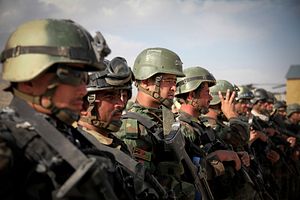As the 2016 fighting season between government and Taliban forces continue, Afghan forces once again find themselves on the defensive. Despite relaxed rules of engagement issued by the White House prior to the NATO Warsaw Summit in July, Taliban forces have weathered a barrage of airstrikes by coalition forces, to include new Afghan aircraft like the A-29 Super Tucano, and now find themselves at the gates of several major populations centers, including Lashkar Gah and Kunduz.
Afghan forces have all but abandoned the rural countryside, with reports emanating from the battlefield that in much of rural Afghanistan the government controls but a few administrative buildings. Despite Resolute Support Spokesman Brigadier General Charles H. Cleveland’s positive assessment of Afghan forces, the Taliban continue to gain ground.
During a Pentagon briefing last week Gen.Cleveland said, “What we see is the Taliban are not able to hold any specific terrain. Most important is, they are not able to hold any of the population centers and that’s really what the Afghans have built their entire strategy on for this campaign season, is being able to secure key population areas as well as key infrastructure.”
In an attempt to abandon easily attackable static checkpoints–an issue of contention for Afghan forces during the last fighting season–Afghan forces have withdrawn from scarcely populated areas, with the goal of regrouping, prioritizing terrain, and building a more effective cohesive fighting force. That new strategy has prioritized the protection of cities over rural countryside.
As a result, the new Afghan strategy has created a fortress fiefdom effect. Major cities such as Kunduz and Lashkar Gah have effectively been surrounded and besieged by insurgent forces. In Kunduz, reports indicate that 80 percent of the surrounding villages are controlled by the Taliban, effectively cutting off the city; and only recently have Afghan forces been able to push back Taliban in Lashkar Gah and reopened key roads.
With dwindling supplies and a still ineffective resupply system for Afghan forces, the Ghani administration has had to rely on powerful warlords and militias to protect key population areas. Vice President Abdul Rashid Dostum’s operations in Jowzajan this summer, and Balkh governor Mohhamed Attah Noor’s various human rights violations over his use of private militias in northern Afghanistan underscore the conundrum Kabul finds itself in.
Ghani, an academic specializing in failed states, opened his administration with the hopes of reigning in militias and fighting corruption, but he has largely failed at balancing Afghanistan’s corrupt patronage networks. The poor performance by Afghan forces and decreasing foreign aid has forced Ghani into supporting strongmen throughout the country. Even Zahir Qadir, deputy speaker of Parliament, was accused of supporting militias in Nangarhar province who were carrying out extrajudicial killings and beheadings of Islamic State militants.
The start of Operation Shafaq by Afghan forces this spring was an attempt to keep the Afghan military on the offensive and disrupt Taliban operations. However, the operation has only highlighted a major vulnerability with Afghan forces. Despite initial successes at the start of the operation, the regional focus of operations underscores a vital problem with Afghan forces: They don’t have the proper command and control function to launch simultaneous operations theater wide.
Taliban forces have taken advantage of this vulnerability by launching coordinated attacks in different regions throughout the country. With a dispersed light footprint, Taliban forces have been able to operate with speed and mobility. As operations in Kunduz got underway, Taliban forces exploited Nangarhar province. After Afghan forces launched a major operation in Nangarhar in July, Taliban forces disrupted Helmand. Commando forces dispatched rapidly, along with 100 U.S. soldiers, to save the beleaguered capital of Lashkar Gah. With heavy fighting underway in Helmand, the Taliban launched another attempt to sack Kunduz city, resulting in the collapse of Khanabad district and General Murad’s departure from Helmand to Kunduz.
For the most part, Afghan forces have been able to maintain control of key population centers, and the rapid deployment of Afghan commando forces have been a vital key component of battlefield successes for Afghan forces. However, the overreliance on Kabul’s new Praetorian Guard is another vulnerability for Afghan forces. Few in numbers, and constantly on the front lines spearheading assaults for conventional Afghan forces, Afghan commandos have found themselves overworked and stretched too thin. Because of the Afghan military’s overreliance on these commando forces, training, equipping, and funding this highly capable force has at times come at the expense of more conventional forces.
This fighting season is another learning experience for Afghan forces. How many more they can take at this tempo and pace before breaking is anyone’s guess.

































